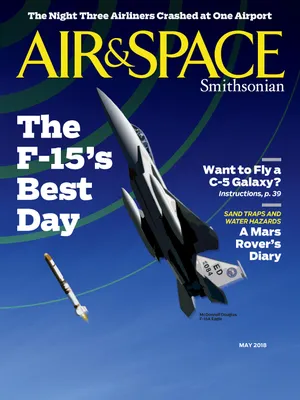NASA’s On-Again, Off-Again Satellite
Amateur astronomers never know what signals they might pick up.
/https://tf-cmsv2-smithsonianmag-media.s3.amazonaws.com/filer/ad/9b/ad9bcb4d-84d9-450b-9711-30b9a601423a/24a_am2018_aurora_33584905191_5f0a2300b5_oa_live.jpg)
A satellite lost 13 years ago was just, briefly, found. Now a group of optimistic technicians may have a chance to bring it back into the fold. In January, amateur astronomer Scott Tilley of British Columbia sat in his home, scanning radio frequencies for the U.S. Air Force satellite lost after a January 7 SpaceX launch. Tilley indeed found a lost satellite, but not the one he intended. Using a satellite catalog, he looked up its transmitter frequency and spin rate, and realized he had to alert NASA.
Back in 2005, the space agency suddenly lost contact with IMAGE, the Imager for Magnetopause-to-Aurora Global Exploration, a solar wind observer. Launched in 2000, the mission was already three years past its expected duration. Still, the team decided to try contacting it again two years later, when a 2007 eclipse cutting off the satellite’s solar-powered systems would force a reboot. But IMAGE stayed silent, and NASA declared the spacecraft lost.
Richard Burley, former IMAGE mission director, isn’t sure how the spacecraft came online, but suspects a flaw in the power system, which the team encountered in 2004, could have been triggered again, restarting the computer and putting it into a 72-hour reboot cycle. “We cannot tell exactly how long it has been in this mode,” says Burley, but amateur astronomers have looked back at their data and found IMAGE’s signal as far back as October 2016.
Now the IMAGE team is trying to reestablish an old relationship—a challenge, since many of the systems launched on IMAGE over a decade ago are today obsolete. (Burley had to search for a 4mm tape reader, finally finding a spare from the 22-year-old Solar and Heliospheric Observatory mission.)
Then on February 25, IMAGE went worryingly quiet again—but not in the same manner it did in 2005, says Burley. He suspects there’s an issue with IMAGE’s spin axis in relation to its medium-gain antenna placement. If NASA can regain control of the spacecraft, it will decide if it can fund a mission restart.
The quixotic tale of a wayward satellite could have a happy ending yet.
